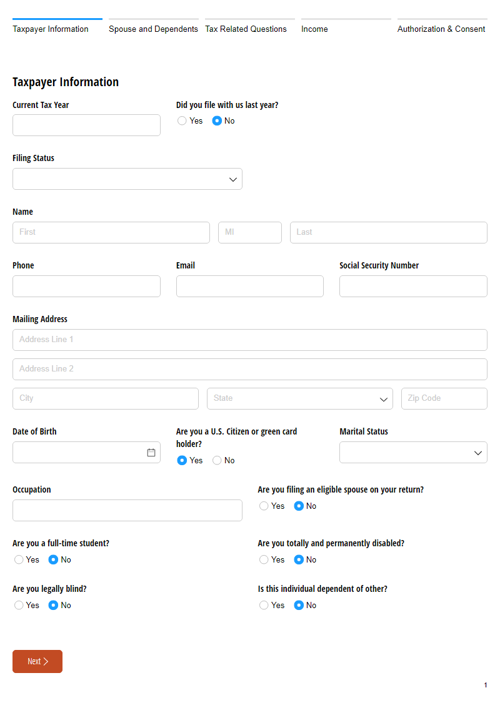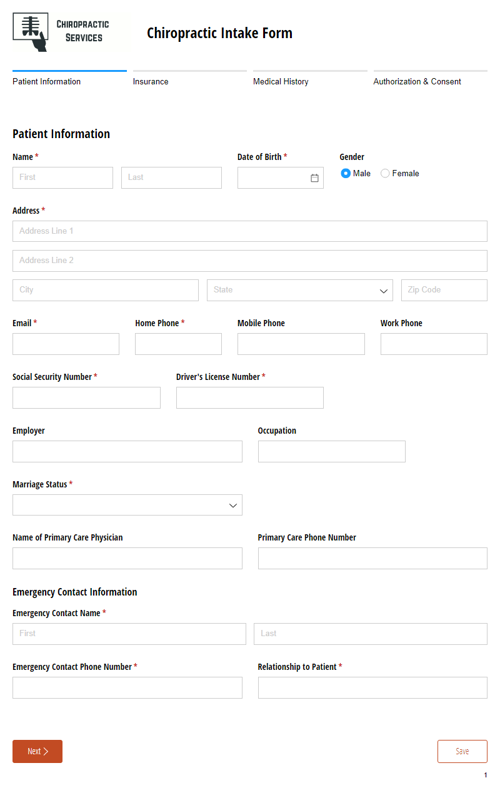Client intake forms are often the first introduction between your business and a new customer. They collect all the essential information upfront, setting the stage for you to focus on building a smooth working relationship.
For businesses with limited time and resources, a well-designed intake form can save hours of back-and-forth by gathering the correct details the first time. By streamlining the onboarding process, you make a strong first impression on clients and ensure no critical details slip through the cracks.
The result is an onboarding workflow that feels organized, client-focused, and easy – an asset for any growing business.

What Is a Client Intake Form?
A client intake form is a questionnaire or document used to capture important information from a new client at the start of your relationship. This form typically asks for contact information, background details about the client’s needs or case, and any other data required to begin providing your service.
The exact questions will vary by industry – a law firm’s intake form will look different from a marketing agency’s – but the purpose is to kick off the client relationship on the right foot with all relevant info in hand.
Intake forms play a key role in gathering the information needed to serve clients effectively from day one, across various industries, including legal, healthcare, and creative agencies.
Best Practices for Client Intake Forms
More than collecting data, client intake forms should create a positive first impression. Following the best practices ensures your form is easy for clients to complete and that you get the information you need.
-
Keep the form concise and relevant
Clients are more likely to complete straightforward and to-the-point forms. Focus on asking only the questions relevant to their current needs. -
Contact and personal information
Capturing the client’s full name, email address, phone number, and mailing address is essential for clear communication and record-keeping. Always mark these fields as required to avoid missing crucial contact information. -
Background and needs assessment
Understanding the client’s situation or project goals upfront helps you deliver tailored services. Ask relevant background questions to set the foundation for a successful work relationship. -
E-signatures for consent or agreements
An electronic signature field allows clients to review and accept privacy policies, service agreements, or other vital documents directly within the form, creating a complete and legally compliant onboarding experience. -
File uploads to gather necessary documents or identification
Enable secure file uploads so clients can easily provide the required documentation, such as IDs, insurance cards, or project briefs, without needing separate unsecured email exchanges. -
Brief introduction and instructions
Set expectations upfront with a short introduction that explains the form’s purpose, how long it should take to complete, and what happens after submission. Clear guidance builds client confidence. -
Prefill data you already have
Pre-populate fields with any existing client information to make the process even easier. Users can confirm or update outdated details, improving accuracy and saving time. You can prefill through email links or by pulling information from an integration. -
Integrate with current systems
Integrating your intake forms with your CRM, project management tools, and other software ensures a seamless flow of data across your business systems. Integrations eliminate redundant data entry, reduce errors, and speed up your workflow from the first client touchpoint. -
Relevant industry-specific questions
Every industry and business will have unique information needs. Add specific fields related to your services to gather all pertinent information immediately.
Client Intake Forms by Industry
Client intake forms are flexible and can be tailored to meet the unique needs of different industries. Customization helps organizations efficiently gather the correct information and deliver better client experiences.
Legal Services
Law firms use intake forms to capture client details and case specifics while ensuring confidentiality and compliance.
- Confidentiality agreement and acknowledgement
- Case type and details
- Conflict of interest screening
- Referral source
- Payment details
Healthcare & Therapy
Healthcare providers collect any information with intake forms to enhance care and maintain HIPAA compliance.
- Medical history and current conditions
- Insurance provider information
- Consent for treatment and HIPAA acknowledgment
- Emergency contact details
- Appointment preferences
Utilities & Home Services
Using intake forms, utility companies gather client information to set up new service accounts quickly and securely.
- Service address and contact info or entry details
- Service start date and preferences
- Terms of service agreement
- Billing details
- Consent and liability agreement
Software Teams & IT Projects
Software firms use intake forms to align project scope, technical needs, and client expectations.
- Project description and goals
- Technical requirements and platform preferences
- Timeline and budget constraints
- Existing system integrations
- Primary points of contact and stakeholders
Marketing & Creative Agencies
Marketing teams collect brand insights and campaign goals on intake forms to craft effective strategies.
- Company background and brand voice
- Target audience details
- Marketing objectives KPI’s
- Past campaign history
- Asset, branding, or style guide uploads

After covering the basics and industry-specific elements, there’s more you can do to enhance your intake process by digitizing your forms.
Benefits of Using Online Intake Forms
Intake forms can be paper or digital, but more organizations are moving to online intake forms that clients can complete on a computer or phone before the first meeting.
Beyond data collections, the benefits of using an online intake form include:
-
Greater efficiency and accuracy
Online forms eliminate the need for manual data entry from paper, saving time and reducing transcription errors. You can build validation rules into fields to ensure the information collected is accurate and complete. -
Better client experience
Online forms allow clients to fill out forms at their own pace, on their own device, and even save progress to resume later if needed. This flexibility removes pain points that many people have with paper forms. Instead of spending the first appointment scribbling down details, you and your client can focus on an actual discussion. -
Workflow automation and integration
Online intake forms don’t just collect information – they can also kick off automated workflows. When a client submits a form, you could automatically send a confirmation email, create a new client record in your CRM, or notify team members to schedule a follow-up. Popular form builders support integrations with many apps, so your intake data flows where you need it. -
Compliance and data security
Online forms enhance privacy and data compliance, which is crucial when handling sensitive personal information. Features like encryption and access controls keep client information secure. In fields like healthcare or legal, look for an online form builder that meets HIPAA or other regulatory requirements. -
Clear progress tracking
With online forms, you can easily track the status of each client’s onboarding – from the initial form submission to internal review and any other step you build into your workflow. Having clear visibility into where each client is in the process improves team coordination and ensures no client falls through the cracks.
Advanced Features to Enhance an Online Intake Form
Advanced features can handle complex scenarios that simple forms might not.
-
Conditional logic for dynamic questions
Keep your forms short and relevant, using conditional logic only to show questions based on the client’s previous answers. This streamlines the user experience and prevents overwhelm. -
Repeating sections to fit every client’s needs
Sometimes clients need to provide multiple sets of information, such as listing several family members, projects, or locations. Repeating sections allow clients to dynamically add as many entries as needed without cluttering the main form. This keeps the form concise for most users while giving flexibility to those who need it. -
Validation and required fields
Implement field validation (such as requiring a proper email format or verifying an address) to maintain the quality of the collected data. Mark essential fields as required so critical information is never missed. -
Multi-page layout with save/resume
For longer forms, splitting content into multiple pages improves readability. Offering a save and resume feature allows clients to complete the form conveniently without losing progress. -
Mobile-friendly design
Ensure your intake forms are responsive and easy to complete on smartphones and tablets. A mobile-optimized design encourages higher completion rates and accessibility for all clients.
All the design elements and features covered come together to create a strong onboarding experience for your clients.
Intake Form Templates
Create forms effortlessly—start from scratch or kick things off with a ready-made client-intake template. Simply pick and save the template, then tailor every detail to suit your exact needs.
Empower Your Onboarding with Better Intake Forms
A well-designed client intake form is the foundation of a successful client relationship. With an online form, you’ll collect essential information accurately, protect sensitive data, and provide a seamless experience for your clients.
Online intake forms are more than a convenience - they’re a competitive advantage. By automating intake, integrating it with your systems, and using professional tools like Cognito Forms, you create an onboarding process that impresses clients and saves your team time.
FAQ
An intake form is a document or digital form used to collect essential information from a new client before services begin. It typically asks for contact details, relevant background information, goals, and any industry-specific data needed to provide personalized and effective service. Intake forms set the foundation for a smooth and professional onboarding experience.
Intake forms serve several key purposes:
-
Capture client information: Name, contact, address, preferences, etc.
-
Understand client needs: Helps tailor services from the outset.
-
Legal & compliance requirements: Includes consent forms, HIPAA agreements, or NDAs.
-
Save time: Reduces back-and-forth communication during onboarding.
-
Automate Workflow: Triggers next steps in process - like CRM entries, emails, or scheduling.
They are used across industries, including legal, healthcare, marketing, home services, and IT.
You can create a client intake form using online tools like Cognito Forms.
- Choose a template or start from scratch.
- Add relevant fields to your business or industry.
- Include conditional logic to tailor questions based on responses.
- Enable file uploads to gather necessary documents.
- Add e-signatures for agreements or consent.
- Integrate with your current business systems (CRM, email provider).
- Test your form and ensure data flows as expected.
Cognito Forms offers industry-specific intake form templates, which make it easy to get started.
If you offer any kind of personalized service or need to collect information before working with a client, the answer is almost always yes. Intake forms are especially critical for:
- Regulated industries (legal, healthcare) where compliance is legally required.
- Service-based businesses that require background and details before starting work.
- Any business looking to automate and streamline client onboarding.
Even small businesses benefit from intake forms by reducing administrative work, increasing professionalism, and improving client satisfaction.




